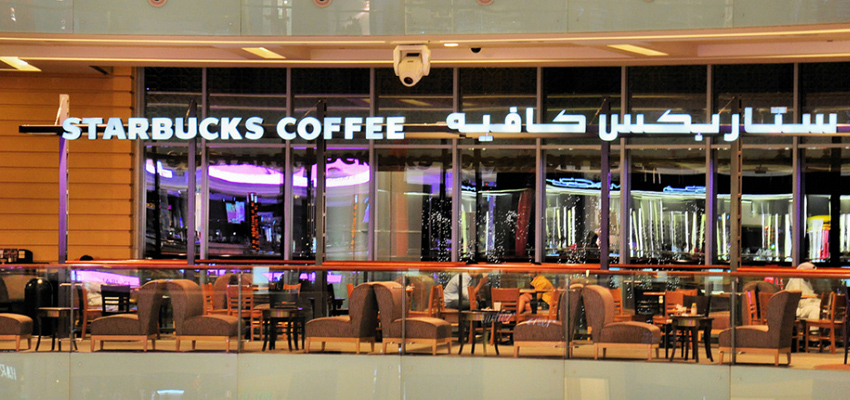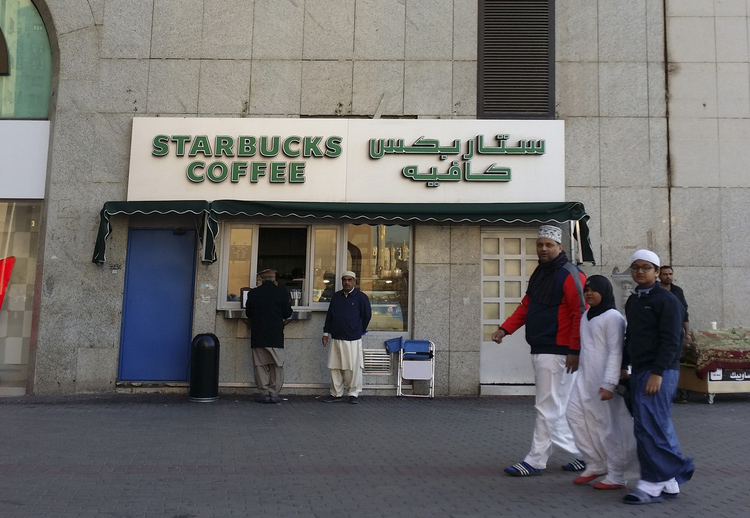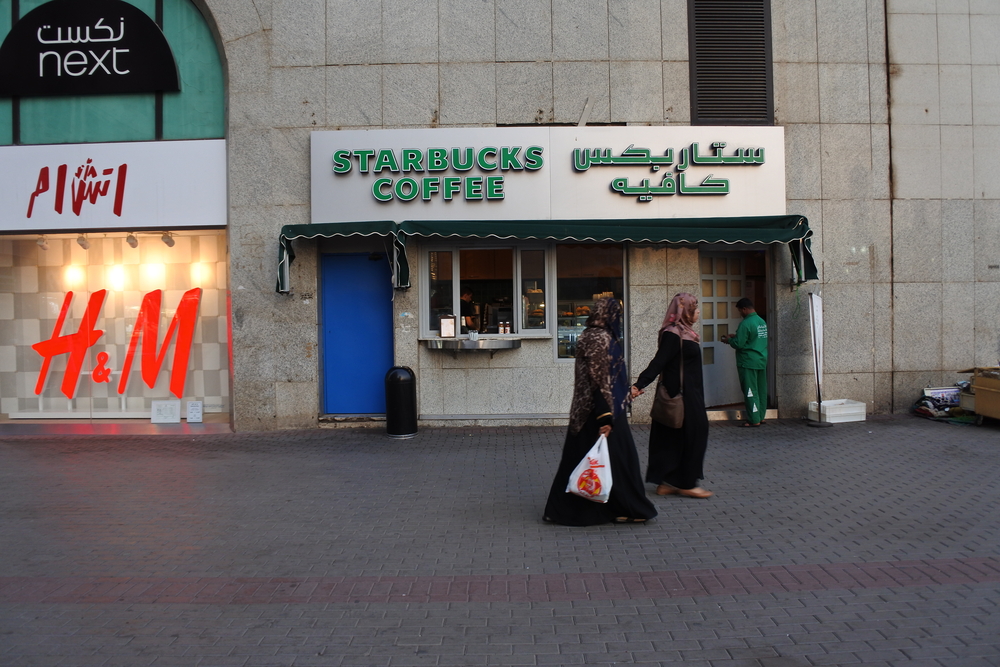
Coffee and coffee shops are an integral part of Middle East culture, with many claiming that the ancient roots of coffee consumption rest in the Arabic-speaking world. A classical Arabic Abd al-Khadir ode to coffee claims it to be “the beverage of the friends of God.” Enter Starbucks, an utterly American Seattle-based coffee chain with over 600 stores in 12 Middle Eastern and North African countries, with a client base that is growing every day, and surging revenue throughout the region. How has Starbucks blended ancient Arabic culture with modern marketing into a delicious success? And why does the Middle East love the Starbucks brand?
1. The changing profile of the Middle East consumer is moving toward an affinity for the affordable upscale, which Starbucks has smartly recognized and accommodated. As the average consumer becomes increasingly knowledgeable and demanding, Middle East brands have moved toward a model of authenticity and storytelling, which makes consumers feel both connected and elevated to the brands they interact with. Starbucks swept through America with astonishing popularity in part because of its grasping of a blend of high and low tastes, making average consumers feel elevated yet familiar through their products. Starbucks has smartly sought the same strategy in the MENA region, as increased local franchise opportunities in the Middle East have allowed brands to develop new customer bases.
2. The wildly successful coffee chain has accommodated local tastes in a unique way throughout the world, and the Middle East is no exception. With over 16,700 Starbucks locations in more than 50 countries, rapid expansion of the Starbucks brand has succeeded with a focus on local engagement, with menu items including local flavors throughout the world. In the MENA region, Starbucks has tailored halal menu items to the local customer, with some including halloumi, kashkawane and zaatar wraps, labnah sandwiches, halloumi ciabatta, and sweet blended lattes to satisfy the notorious Arab sweet tooth. Middle East Starbucks locations have even incorporated elements of traditional Arab decor into their interiors, and when Starbucks briefly introduced alcohol into its locations as part of its 2014 Roastery expansion, the Starbucks Middle East locations smartly chose to opt out. In short, attention to local appetites and tastes has proven to engage and sustain customer engagement with Starbucks throughout the Arab world.

3. Another step on the road to Starbucks’ success has included strategic engagement with local economies, including through employment, engagement, and other techniques. Starbucks employs over 10,000 people throughout the MENA region, and places a value on “being part of the fabric of the local community,” through working with local business partners, cities, and acting as a fair employer. Starbucks has also partnered with the Alshaya Group to operate Starbucks locations in Bahrain, Egypt, Jordan, Kuwait, Lebanon, Morocco, Oman, Qatar, Saudi Arabia, Turkey and United Arab Emirates in the Middle East and North Africa region. The Alshaya Group is a respected multinational company that also furnishes franchises throughout Europe and Russia, and building a fifteen-year partnership with such a well-trusted and respected actor in the Middle East is a smart move that has opened doors for Starbucks throughout the region.
4. Community engagement and social outreach have also been part of Starbucks’ success in the Middle East, in forms including support for positive social entrepreneurship. The Starbucks Opportunity Café, allows the company to host professional skill-building workshops for youth throughout the Middle East region on “employability and entrepreneurship subjects”, with the goal of empowering young people to obtain skills that they need for employment and educational opportunities. In addition, Starbucks has partnered with the AMIDEAST Entrepreneur Institute since 2016 as a way to bring local experts and young people together in a social atmosphere to discuss social projects. The Badir Project in Jordan, in particular, has allowed Starbucks to engage directly with Jordanian youth for projects relating to social engagement and development.

5. A savvy social media strategy and presence have also been key to the company’s success in the Middle East, which recognizes that the largely young population of Arab countries engages most frequently with brands through online platforms. With 1,464,361 followers on Starbucks Middle East Facebook and 375,000 followers on the Starbucks Middle East Instagram account, the company has found ways to engage directly with consumers in the MENA region in their own language. The burgeoning YouTube account has worked for the past few years to post inspirational and motivational videos for the brand, smartly recognizing the potential for engagement with consumers in a new format. Outreach in branding has even been adjusted for the region, with a sleek and appealing Arabic-language version of the iconic Starbucks logo and regional adjustments for markets in Saudi Arabia adding to the brand’s appeal.

6. Finally, a unique brand and presence in the region has sealed Starbucks’ appeal and success throughout the Middle East region. Although the ritual of homemade Arabic and Turkish coffee remains distinct, Starbucks has found ways to honor these traditions by creating products that celebrate and expand upon their customers’ needs and interests, rather than attempting to replace them. And with the burgeoning expansion of cheap homemade coffees such as Nescafé, as well as competitors in the region such as Costa, Gloria Jeans, and Caribou Coffee, Starbucks has found ways to create brand loyalty by presenting itself as a more elite, unique coffee option. And by building locations near malls, universities and city centers, Starbucks continues to market itself toward the young and upwardly mobile, and to build new ways of accessing customers.
In short, through attention to local politics and culture, partnerships with strategic actors and involvement in local communities, as well as engagement in customers’ own language, Starbucks has built a brand that has transferred and adapted to the Middle East. By employing these strategies for success and building love among their Middle East customers, Starbucks will continue brewing a delicious blend of local culture and international appeal for years to come.

https://mentalfloss.com/article/24322/10-things-you-dont-know-about-starbucks-should
https://news.starbucks.com/views/facts-about-starbucks-in-the-middle-east
https://www.worldfinance.com/markets/understanding-the-middle-eastern-luxury-market
http://www.chicagotribune.com/business/ct-starbucks-evenings-20170106-story.html
http://gulfbusiness.com/coffee-in-the-middle-east-a-way-of-life/
https://ashleykonson.com/2013/02/28/canadian-coffee-house-brands-are-thriving-in-the-middle-east/
https://gulfnews.com/business/economy/instant-coffee-brands-rule-mideast-market-1.250808
Written By Eliza Campbell


